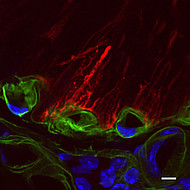Interaction between Tanycytes and the Hormone Axes
Research Interests
My group is interested in the physiological role of tanycytes, a specialized population of glial cells in the ependymal layer of the 3rd ventricle. The cell bodies of tanycytes contact the CSF and send long projections into the parenchyma of the basal hypothalamus and the median eminence, where they contact blood vessels. Tanycytes are in a strategic localization to control the blood-CSF barrier of the median eminence, the transport of substances over this barrier as well as in the regulation of the hormone release into the portal venous system of the median eminence. However, little is known about their functions and the underlying mechanisms.
Our main focus is to clarify the role of tanycytes in the regulation of the energy homeostasis, the barrier function as well as their influence on the release of hormones of the hypothalamus-pituitary axis. To investigate these topics, we have established new genetic and viral tools to specifically manipulate tanycytic functions in vivo. With these tools we are able to knockout or overexpress genes especially in tanycytes and to investigate the structural and genetic consequences as well as changes in the phenotype of the animals. For these purposes we use indirect calorimetry, behavioral tests, and hormonal assays as well as laser microdissection to analyze changes in gene expression.
Collaborations
- Rubén Nogueiras, University of Santiago, Spain
- Vincent Prévot, INARM Lille, France
- Heike Heuer, University of Essen, Germany
- Jens Mittag, University of Luebeck, Germany
- Dennis Schade, University of Kiel, Germany
Selected Publications
Di Spiezio, A., E.S. Sandin, R. Dore, H. Müller-Fielitz, S.E. Storck, M. Bernau, W. Mier, H. Oster, O. Johren, C.U. Pietrzik, H. Lehnert, and M. Schwaninger. 2018. The LepR-mediated leptin transport across brain barriers controls food reward. Mol Metab 8:13-22.
Harder, L., S. Dudazy-Gralla, H. Müller-Fielitz, J.H. Leffler, B. Vennstrom, H. Heuer, and J. Mittag. 2018. Maternal thyroid hormone is required for parvalbumin neurone development in the anterior hypothalamic area. J Neuroendocrinol 30:
Müller-Fielitz, H., N. Hubel, M. Mildner, F.M. Vogt, J. Barkhausen, and W. Raasch. 2014. Chronic blockade of angiotensin AT(1) receptors improves cardinal symptoms of metabolic syndrome in diet-induced obesity in rats. Brit J Pharmacol 171:746-760.
Müller-Fielitz, H., M. Lau, C. Geissler, L. Werner, M. Winkler, and W. Raasch. 2015. Preventing leptin resistance by blocking angiotensin II AT(1) receptors in diet-induced obese rats. Brit J Pharmacol 172:857-868.
Müller-Fielitz, H., M. Stahr, M. Bernau, M. Richter, S. Abele, V. Krajka, A. Benzin, J. Wenzel, K. Kalies, J. Mittag, H. Heuer, S. Offermanns, and M. Schwaninger. 2017. Tanycytes control the hormonal output of the hypothalamic-pituitary-thyroid axis. Nat Commun 8:
Schade, D., J. Kotthaus, L. Riebling, J. Kotthaus, H. Müller-Fielitz, W. Raasch, A. Hoffmann, M. Schmidtke, and B. Clement. 2015. Zanamivir Amidoxime- and N-Hydroxyguanidine-Based Prodrug Approaches to Tackle Poor Oral Bioavailability. J Pharm Sci-Us 104:3208-3219.

- Forschung
- Bridging Brain Barriers
- Cellular Electrophysiology
- Cerebral Perfusion and Metabolism
- Influence of RAAS on the Metabolic Syndrome
- Interaction between Tanycytes and the hormone axes
- Neuropeptides and Energy Homeostasis
- Neuroplasticity and Rhythms
- Pharmacovigilance
- WATCH group
- STED microscopy
- Publications
- Memberships
- Seminars
- Awards
- Technologies/Resources


